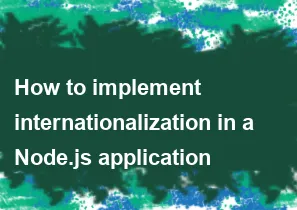How to implement internationalization in a Node.js application

Internationalization (i18n) is the process of designing and preparing your application to support multiple languages and regions. In a Node.js application, you can implement internationalization using various libraries. One popular library for i18n in Node.js is i18next. Here's a step-by-step guide on how to implement internationalization in a Node.js application using i18next:
Step 1: Install i18next
bashnpm install i18next i18next-node-fs-backend
Step 2: Set Up Your Project Structure
Create a directory structure for your translations. For example:
plaintextproject-root |-- locales | |-- en | | |-- translation.json | |-- fr | |-- translation.json |-- src | |-- app.js |-- package.json
Step 3: Create Translation Files
Inside the locales directory, create JSON files for each language. For example, en/translation.json:
json{
"welcome": "Welcome to our application!",
"greeting": "Hello, {{name}}!",
"farewell": "Goodbye!"
}
And fr/translation.json:
json{
"welcome": "Bienvenue dans notre application!",
"greeting": "Bonjour, {{name}}!",
"farewell": "Au revoir!"
}
Step 4: Configure i18next
In your app.js file, configure and set up i18next. Here's a basic example:
javascriptconst i18next = require('i18next');
const fsBackend = require('i18next-node-fs-backend');
i18next
.use(fsBackend)
.init({
lng: 'en',
fallbackLng: 'en',
backend: {
loadPath: __dirname + '/locales/{{lng}}/translation.json',
},
});
// Example usage
const welcomeMessage = i18next.t('welcome');
console.log(welcomeMessage);
Step 5: Use i18next in Your Application
Now you can use i18next to translate strings in your application. Use the t function to get translations:
javascriptconst i18next = require('i18next');
const fsBackend = require('i18next-node-fs-backend');
i18next
.use(fsBackend)
.init({
lng: 'en',
fallbackLng: 'en',
backend: {
loadPath: __dirname + '/locales/{{lng}}/translation.json',
},
});
const name = 'John';
const greetingMessage = i18next.t('greeting', { name });
console.log(greetingMessage); // Outputs: Hello, John!
Step 6: Change Language Dynamically
You can change the language dynamically by updating the lng property in the configuration and reloading translations:
javascripti18next.changeLanguage('fr', (err, t) => {
if (err) return console.log('something went wrong loading', err);
console.log(i18next.t('welcome')); // Outputs: Bienvenue dans notre application!
});
That's it! You've now implemented internationalization in your Node.js application using i18next. Adjust the configuration and usage based on your application's needs.
-
Popular Post
- How to optimize for Google's About This Result feature for local businesses
- How to implement multi-language support in an Express.js application
- How to handle and optimize for changes in mobile search behavior
- How to handle CORS in a Node.js application
- How to use Vue.js with a UI framework (e.g., Vuetify, Element UI)
- How to configure Laravel Telescope for monitoring and profiling API requests
- How to create a command-line tool using the Commander.js library in Node.js
- How to implement code splitting in a React.js application
- How to use the AWS SDK for Node.js to interact with various AWS services
- How to use the Node.js Stream API for efficient data processing
- How to implement a cookie parser middleware in Node.js
- How to implement WebSockets for real-time communication in React
-
Latest Post
- How to implement a dynamic form with dynamic field styling based on user input in Next.js
- How to create a custom hook for handling user interactions with the browser's device motion in Next.js
- How to create a custom hook for handling user interactions with the browser's battery status in Next.js
- How to implement a dynamic form with dynamic field visibility based on user input in Next.js
- How to implement a dynamic form with real-time collaboration features in Next.js
- How to create a custom hook for handling user interactions with the browser's media devices in Next.js
- How to use the useSWRInfinite hook for paginating data with a custom loading indicator in Next.js
- How to create a custom hook for handling user interactions with the browser's network status in Next.js
- How to create a custom hook for handling user interactions with the browser's location in Next.js
- How to implement a dynamic form with multi-language support in Next.js
- How to create a custom hook for handling user interactions with the browser's ambient light sensor in Next.js
- How to use the useHover hook for creating interactive image zoom effects in Next.js